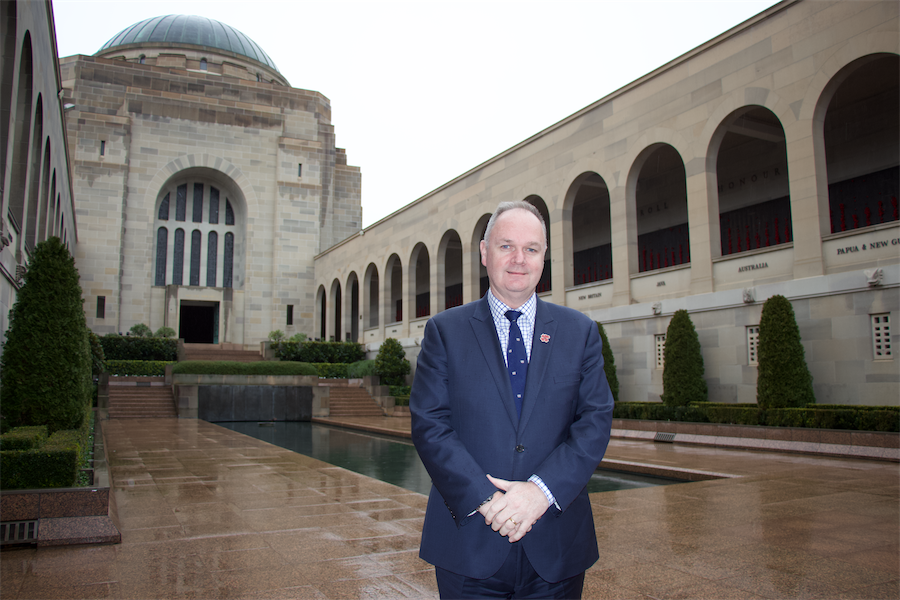
THE Australian War Memorial’s new director, Matt Anderson, stepped into the role in April with the goal to keep the memorial relevant.
Part of that is taking charge of the once-in-a-generation attempt to create additional space to tell the stories of the women and men who have served, says the former diplomat and soldier.
The memorial’s controversial half a billion dollar expansion plan will see Anzac Hall demolished, a move the Australian Institute of Architects has labelled as “grossly wasteful and unnecessary”.
But Matt says the debate has become “about the building rather than the stories we’re seeking to convey within it.”
“I genuinely wish that Anzac Hall had been built back in 2001 in such a way that it could have been readily expanded, but sadly it hasn’t been,” Matt says.
“I understand that [there are people] attached to that building, as is anyone who visits it, but what I believe is that the heritage value of the memorial, and certainly the heritage value of Anzac Hall is, in large measure, the value of the things that are in it and the stories that are told within it.”
The retention of Anzac Hall was “absolutely considered” and it was looked at from a cost-benefit analysis and from a practical municipal logical advantage.
“In 15 paces, of my paces, I will go from Vietnam to the Tarin Kowt Wall. In 15 paces, I’m telling the story of 66 peacekeeping missions, in 15 paces I’m telling the story of 72,000 women and men who have been deployed to the Middle East Area of Operations,” Matt says.
“As you walk through, you have Somalia on your left and Rwanda on your right and Cambodia on your left and East Timor on your right and then suddenly you’re in the Gulf and then you’re in Iraq and then you’re in Afghanistan and Afghanistan is in a hall, an exit corridor.
“We can do better because part of the importance of continued relevance is it needs to be relevant for current serving; it’s a continuing story.
“We have been unable to tell these stories in the same level of detail.
“If the government sends women and men into harm’s way, when they come home, they should be able to come here and find a touch point to that service, they should be able to come home and find recognition of that service, they should be able to come here and feel the thanks of a nation that sent them there.
“This is our chance to do a precinct-wide development from the front entrance to Anzac Hall, to expanding the Bean Centre and the research centre, to getting non-gallery functions out of the main memorial building… so we’re not only able to tell the stories to now, but we have room to tell the stories going into the future.”
There are many people who have missed out on being honoured and having their stories told through the memorial, Matt says.
“Just a couple of weekends ago I was in the peacekeeping area and a guy walked up to me looking for the South Sudan section,” he says.
“He was looking to see where his story was told so he could show his family and it wasn’t there.”
Matt was born in Victoria and moved to Canberra as a teenager to go to the Royal Military College, Duntroon, before holding military posts across the nation, and then leading a defence project in Tonga.
He then joined the Department of Foreign Affairs and Trade (DFAT) in 1995, where he held senior positions and postings in countries such as Samoa, South Africa and Afghanistan.
One story he thinks people should be proud about is the work of HMAS Tobruk during Samoa’s 2009 earthquake and tsunami.
Matt was the high commissioner to Samoa at the time and says people should also be proud of the civilians, the doctors, the nurses, the anaesthetists, the AFP and others who came to support Samoa at the time. “This is genuine humanitarian, well-intentioned, well-targeted, life-saving work that was done by members of the Australian Defence Force in our name,” he says.
So, as the memorial’s custodian, Matt says he will continue to push to tell these stories and to keep the memorial relevant.
“The Australian War Memorial belongs to all Australians and for many who thought they wanted to come but haven’t, this is their chance,” he says.
“The memorial is not a glorification of war, it’s a place where we celebrate ordinary Australians who proved capable of the extraordinary.”
Who can be trusted?
In a world of spin and confusion, there’s never been a more important time to support independent journalism in Canberra.
If you trust our work online and want to enforce the power of independent voices, I invite you to make a small contribution.
Every dollar of support is invested back into our journalism to help keep citynews.com.au strong and free.
Thank you,
Ian Meikle, editor









Leave a Reply